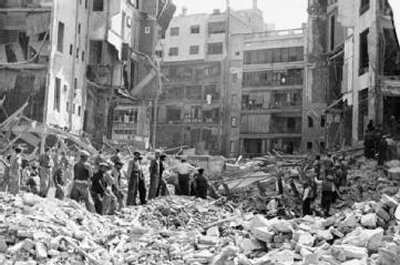¡No Pasarán! Madrid: The Crucified City
The air raids which succeeded the Battle for Madrid in late 1936 became one of the first in history to target civilians. Franco personally ordered the bombardment of the city's residential areas, with the exception of the Salamanca district. This wealthy area of central Madrid housed the core of support for Franco and the insurgency within the city.
So why did Franco order such a cynical airborne assault?
The failed coup d'état of April 1936 projected itself into Civil War, the cruellest form of conflict. Mola and Franco wanted a swift defeat of the Republic which was in disarray. The Government couldn't trust the army and the Civil Guard had defected in numbers, only the assault guard remained loyal. The Militias, mainly the Anarchist CNT and UGT trade union were given arms, even if of poor quality. Of more than 50,000 rifles given to them, only some 5,000 actually worked. Madrid was there for the taking.

Photo - https://www.iwm.org.uk/
The dash for the capital, La Marcha as it became known, involved columns moving on Madrid from the north and south. Elements of the Army of Africa, Ejército de África, moved north from Seville. After securing the Portuguese border and taking the town of Badajoz, they would link with Mola's columns moving south. The mode of advance was to be swift. Only engaging Republican forces which could threaten the overall strategy. Republican forces fought several battles, trying to halt the northward march of the Madrid Columns.
With the defences of Madrid not yet complete and the arming of the militias still under way, Madrid lay open. Franco however ordered the columns to detour to Toledo to relive the siege of the alcázar. The question of why Franco took this decision remains unanswered. The defence of the alcázar became legend among the Nationalists and their supporters. It had become so celebrated that perhaps he thought he had no choice but to take the action he did. The surrender of the alcázar would have freed thousands of republican troops to harass the columns from the rear.
Whatever the reason it allowed the organisation of Madrid’s defences. Mola´s fifth column inside Madrid itself, saboteurs and informers, kept the advancing nationalists up to date with preparations. The effect of the delay must have been apparent to the advancing troops.
By the 7th of November 1936 the battle for Madrid was imminent.
The Nationalist columns intended to attack through the Casa de Campo after a diversionary feint against the Carabanchel areas of south eastern Madrid. The Army of Africa being ideally suited to this type of warfare. Advancing over open ground.
Republican reconnaissance units discovered intelligence in a captured Italian tank outlining the area of attack and details of the diversionary action. The Republican commanders deployed some 28,000 of their troop in the Casa de Campo with 12,000 remaining in the southern suburbs. With the assault halted both sides dug in. The nationalist then tried to press home their attack in the Carabanchel districts, where they had made the first diversionary drive. Franco's Army of Africa couldn't adapt to street fighting whereas the militias opposing them were probably born and bred in the very area. The resultant stalemate lasted until March 1939 with very little change in the relative positions of the belligerents. The battle lasted until the 23rd of November.
It was the militias who stopped the initial Nationalist advance on Madrid. The first column of the Internationals Brigades, the 11th Brigade, took an active part on the 8th of November. There were many reasons Franco did not to take Madrid in the early months of the War. The delay while the siege of Toledo’s alcázar was lifted, committing troops more used to warfare in the desert to street fighting. The failure to surround and isolate Madrid with the roads to Barcelona and Valencia remaining open until after the Battle of the Ebro in November 1938.
Was it Franco's frustration with the stubbornness of Madrid's defenders which caused him to order the aerial bombardment?
One may be cynical and suggest that the intervention of Hitler and Mussolini had something to do with it. The fascists of Germany and Italy had invested a great deal in the Spanish Civil War. They needed to test the resolve of the democracies. Hitler always believed they wouldn't fight. He had new untried weapons and tactics. The blitzkrieg looked good on paper but he needed practical proof.
Was it on Hitler's orders that Madrid be given time and allowed to prepare? He needed the right conditions for his experiments.
Franco swore he would destroy Madrid rather than leave it in the hands of the republic. From the 19th of November German bombers supported by Italian fighter aircraft hit the city. Whether Franco or Hitler initiated the air raids is arguable, but their effect was a propaganda failure with limited strategic success.
Foreign correspondents attacked the bombing in their newspapers across the globe. Notable observers like Hemingway berated the Nationalists for their action. Photographers such as Robert Capa produced images of the distraught population amongst the ruins of their homes.
Some bombs were said to be anti-personal, making a small crater but spewing sub-munitions laterally. The number of casualties and the tonnage of the bombs dropped is unknown. In one day Junkers 52s delivered 36 tons. Nowhere near as intensive as the raids during the second world war, but the art was still being developed.
By early 1937 Republican fighter opposition forced the bombers out of the sky during daylight hours reducing their effectiveness. The land battle to the west of Madrid became virtually static with both sides exhausted. Life in Madrid became surreal.
Officers would leave their hotels and go to the trenches by tram. When their shift was over they would simply catch a tram home again. The battle grounds of the Casa de Campo and the University City became one of the sights of Madrid.
The bombing did not terrorise the people of Madrid into submission. Even during the most intensive period from the 19th to the 23rd of November 1936, trams still operated and the daily search for food continued. Of the many lessons that the axis powers learnt from the bombing of Madrid the most important element remained unlearned. Masses of data in terms of equipment and tactics gave Hitler and Mussolini a valuable military insight into air warfare. However, the resolve of the people of Madrid only stiffened in the face of the aerial bombardment.
The people of London, Nottingham and Liverpool to name but three cities showed the same resolve and courage. A resolve which was eventually victorious, unlike people of Republican Spain.
If the democracies had taken a stand in Spain, would there have been a blitz on British cities? In that event would the reward for the sacrifices of the madrilènes been victory?
John MacDonald - www.caratacus.eu
